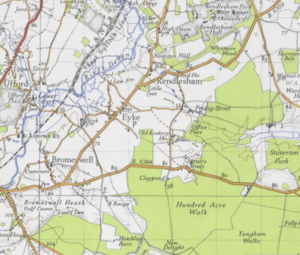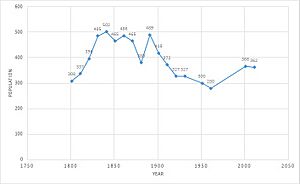Eyke facts for kids
Quick facts for kids Eyke |
|
|---|---|
 |
|
| Area | 12.62 km2 (4.87 sq mi) |
| Population | 362 (2011 Census) |
| • Density | 29/km2 (75/sq mi) |
| OS grid reference | TM 31702 51796 |
| Civil parish |
|
| District |
|
| Shire county |
|
| Region | |
| Country | England |
| Sovereign state | United Kingdom |
| Post town | Woodbridge |
| Postcode district | IP12 |
| Dialling code | 01394 |
| Ambulance | East of England |
| EU Parliament | East of England |
Eyke is a small village and civil parish located in the East Suffolk area of Suffolk, England. You can find it near the town of Woodbridge, close to the A1152 road. Eyke is home to a primary school, a beautiful manor house with a pond, and a local pub. The old All Saints Church, which dates back to medieval times, was fixed up in the 1860s. Church services are usually held on the first and third Sundays of each month.
The parish of Eyke covers about 2,749 acres. In 2011, about 362 people lived here. The village is looked after by the Eyke Parish Council, which has seven local councillors.
Contents
Eyke's Early History
The name 'Eyke' comes from the word 'Oak'. Over time, its spelling changed many times, like "Eike," "Ike," and "Yke." Eyke was first mentioned a long time ago, during the reign of King Henry II (around 1171–1185). We know that someone named Adam de Eik had to pay a fine back then, but we don't know why!
People in Eyke sometimes stood up for themselves. For example, in 1310, they broke into the Manor House of Eyke Rectory. They opened a chest to destroy records about what they owed to Robert de Redenhale. Later, in June 1381, during a big peasant uprising, they broke into John Staverton's home. They destroyed records and took things worth 100 shillings. It's not clear if this was for political reasons or just theft.
There are also stories from the late 1500s. People in Eyke were fined because they kept wearing German felt hats on Sundays and holidays. The authorities wanted them to wear English hats instead! Another time, in 1644, some villagers complained about John Stoneham. He was the local church leader, and they didn't like how he ran the church services or his general behaviour. We don't know if anything came of this complaint.
For a long time, Eyke mostly depended on farming. It was a very self-sufficient village. Before the First World War, there were six separate farms and many small plots of land. Most families also kept chickens and a pig, and grew their own vegetables. Other local jobs included shoemakers, a blacksmith, a hurdlemaker (someone who makes fences), a thatcher (who puts straw roofs on houses), a builder, and a carpenter. The carpenter was also the undertaker! Most of the farmland belonged to the Rendlesham Estate until it was sold in 1920.
How Eyke's Population Changed
The first detailed count of people in Eyke was in 1801, when 308 people lived there. The population grew steadily. By 1821, it was 396. Then, in 1831, it jumped to 485 people! This big increase might have happened because, at that time, children were seen as helpful for families, which encouraged more births.
In 1851, Eyke reached its highest recorded population of 529 people. It hasn't been that high since. However, by 1881, the population had dropped quite a lot, to 380 people. This big drop might have been due to the cholera outbreak in England in 1854. After this, the population grew again to 489. But from 1891 onwards, the number of people in Eyke slowly went down until the 1960s, when it was 280.
In 2011, Eyke had 362 residents. This is a very small part of the total population of the Suffolk Coastal region, which was 124,298 people at that time.
Jobs in Eyke in 1881
In 1881, we can see what jobs people in Eyke had. Nine women worked in domestic services, like being maids or servants, while no men did. This was common back then, as women often took care of homes and children. Since only a few households employed domestic staff, it suggests that most homes in Eyke were not very large.
Farming was the biggest employer in 1881, with 56 men working in agriculture. No women worked in farming because it was very hard manual labour. If we compare this to today, very few people work in farming in Eyke. The 2011 Census showed that only 18 people worked in agriculture or related jobs.
Today, the most common jobs in Eyke are "Managers, Directors, and Senior Officials." In 2011, 27 people worked in these roles.
Homes and Health in Eyke
In 2011, there were 154 homes in Eyke. These included people living alone, groups, and families. Most homes in Eyke are detached (not connected to other houses) or semi-detached (connected on one side). There were 81 detached houses and 52 semi-detached ones. This suggests that the area is generally well-off. There were no shared homes recorded, and only one caravan or temporary structure.
The health of people in Eyke also seems good. The 2011 Census showed that most people were in "good health" or "very good health." About 192 people were in very good health, and 114 were in good health. This suggests that Eyke has good public health and access to health services.
All Saints Church
All Saints Church is a very old building from the 12th century, built during the Norman period. It is dedicated to All Saints.
One person who visited the church described it like this: "All Saints sits quietly, with no tower to lead you to it from afar. At first sight, this is a simple, if uneven, little church, somewhat barnlike in its ancient graveyard. Tall elm trees around it are home to jackdaws and rooks; their cries fill the air as they wheel above you. The modern little porch gives no indication that you are about to enter one of the more interesting churches in this part of Suffolk."
Sam Mortlock, a former librarian, thought that All Saints Church was probably built in the shape of a cross. Churches built in a "cruciform" (cross) shape were common in the Middle Ages. They are formed when two parts of the building meet at right angles, making the shape of a Latin cross. When the church was first built by "the Manor of Staverton," it was valued at £6.00.





